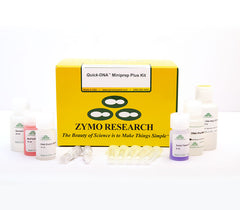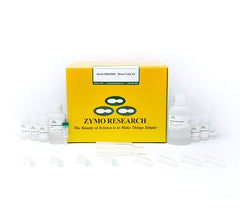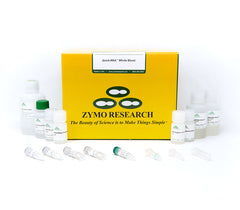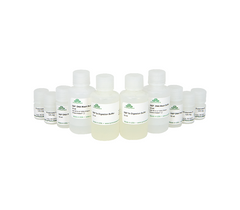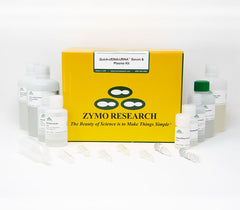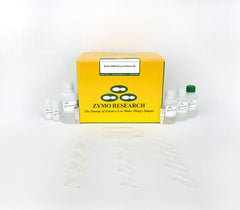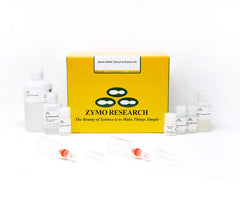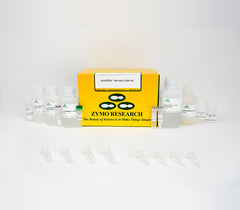Blood Collection Tubes and Kits
Blood collection tubes for the collection and safe room temperature storage of blood samples. Our corresponding plasma, serum and whole blood kits allow for simple, reliable, and efficient preparation and isolation. Specifically, blood collection kits provide quick recovery of DNA and RNA from stabilized samples from blood collection tubes.
What Are Blood Collection Tubes and Kits Used For?
Blood Collection kits come as a box with a pack of fifty evacuated blood collection tubes which are on a Styrofoam rack. The evacuated blood collection tubes are a sterile plastic test tube with a colored rubber stopper creating a vacuum seal inside of the tube, facilitating the drawing of a predetermined volume of human/mammalian whole blood –which is 3mL of whole blood.
Blood collection tubes contain 6 mL of DNA/RNA Shield™ reagent which is designed to stabilize and preserve the specimen. Tubes are gamma-irradiated for sterilization and come labeled with safety, usage and draw volumes. The color of the top is green which has no significant indication, in general the cap color indicates a specific additive or usage of the particular blood collection tubes.
Blood collection tubes are for stabilization, transport, and subsequent isolation of DNA and/or RNA from human or mammalian whole blood specimen for nucleic acid-based analysis, this includes next-generation sequencing and PCR-based methodologies (i.e. transcriptional gene expression analysis).
When mammalian whole blood (3 mL) is drawn into the tube and mixed with this reagent, lysis occurs immediately. The reagent inactivates nucleases and other enzymes in the lysed whole blood, leaving both DNA and RNA in solution safe from degradation.
Human whole blood samples are collected using standard phlebotomy practices directly into the blood collection tubes. Sample specimen can then be immediately processed, stored, or shipped within the same tube, there is no need to transfer or aliquot into another tube or perform additional processing.
Things to Look for in a Blood Collection Device
Blood Collection Tubes are designed to provide a familiar and streamlined collection method of whole blood specimen. The evacuated blood collection tubes themselves use the same plastic mold as the standardized tube type used by phlebotomists – a 16 x 100 mm plastic blood collection tube with rubber stopper cap. This design allows phlebotomists to draw directly into the tube just like any other tube type that they collect into. Furthermore, this universality allows for the incorporation of the blood collection tubes into standard blood draw workflows.
Typically, multiple tubes are drawn from a patient for a wide array of diagnostics or lab tests. The evacuation on the blood collection tubes allows for a controlled blood draw of 3 mL into the tube removing any guess work or having to do any post processing of adding a specific volume of stabilization media to a collected blood sample.
Information and Data Gained from Blood Samples
Blood is a fairly popular sample type for a wide range of diagnostic and lab test – from blood glucose, lipids, to drug tests. For the applications pertinent to our blood collection tubes, most applications would fall under molecular nucleic acid testing. From the blood collection tubes, users have the ability to extract both DNA and RNA (both intracellular and extracellular) meaning this one product allows for the analysis of essentially all types of nucleic acid from blood. Similar blood collection tubes in the market have one tube per analyte of interest (i.e.. A blood tube specifically for intracellular RNA, a blood tube specific for intracellular DNA, etc.).
Popular applications for RNA are primarily for gene expression analysis and profiling. A researcher would do this via Polymerase Chain Reaction (PCR) methods to analyze their gene of interest. Another popular application being Next-Gen Sequencing, which our blood collection tubes are able to provide high quality DNA and RNA for such a sensitive downstream application. These two common types of methods are used for a broad range or applications which include cancer research, microbiomics, pathogen detection and surveillance, and immunology.
Blood is a popular sample type as well in consumer-based genetics in the health and wellness industry. An example being the DNAge epigenetic clock service which from a blood sample collected by a person at home is shipped to a lab for processing. From that blood sample, the DNA epigenetic profile is assessed which can be correlated to the age of the person who submitted the blood sample.
A growing area for blood is that concerning microRNA markers. MicroRNA in blood has been implicated in various fields including cancer research. What has been a limiting factor is that smaller RNA species can be lost due to the collection method or misrepresented through sample processing. What is unique our blood collection tubes and kits is that they do not require precipitation of nucleic acid. Therefore, the sample can seamless plug into a purification system which prevents any loss of small RNA species due to additional processing/precipitation steps.
What's Next for Blood Collection?
Over the past decade there has been a big push away from invasive blood collection into “non-invasive” methods such as saliva collection. However, blood collection still persists to be relevant and technological innovation is pushing for less invasive and even pain-free collection methods of blood samples. Why it persists is primarily due to the sheer amount of tests that can be performed by blood that can’t be performed on other sample types such as saliva due to incompatibilities or lack of the analyte of interest.
There are several companies developing methods of blood collection that do not require the intravenous needle into a patient’s vein, rather through capillary action through a person’s skin. This opens up the door to blood collection to be collected at home by any lay person (non-laboratory trained personnel). Although such methods exist for blood collection at home, they still require a “painful” finger prick via a lancet that a patient must do themselves.
The future of blood is heading into the direction that Theranos intended “200 tests from a drop of blood”… just actually backed by a working system. On the side of blood collection, this means that blood sampling will probably decrease in volume – away from the standard blood collection tubes format which collects milliliters of blood to collecting only microliters of blood. A combination of a painless collection method that can be done by any layperson with a ‘microsampling’ system of blood will be what people will have to work with to perform their desired downstream analyses.
For the next 50 years, the applications from blood will be limited by nucleic acid technologies in general. So, for the most part this will be advances in the understanding of life and addressing disease.

